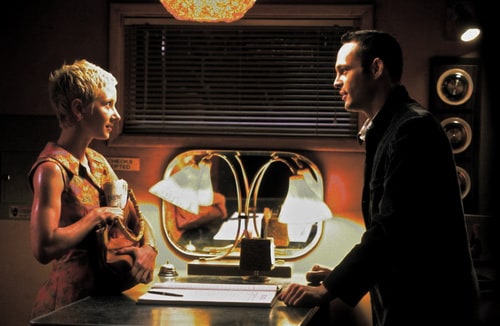Directed by John McNaughton (who arrived on the scene in 1989 with the low-budget shocker Henry: Portrait of a Serial Killer), Wild Things is a twisty, lurid Southern noir tale of sex, scandal and devious plotting. It doesn't take itself too seriously (ala Showgirls), but neither does the film sink into complete camp. Wild Things instead resides somewhere in the middle, and the product is amusing, shocking, erotic and inarguably engrossing.
Because the plot secrets are key to the movie's enjoyability, only a brief outline of the basic set-up will be included in this review.
The story unfolds in the South Florida town of Blue Bay, and centres on a high school guidance councillor named Sam Lombardo (Dillon). Sam's life is turned upside down when he's accused of rape by manipulative rich girl Kelly Van Ryan (Richards) and trailer-trash bad-girl Suzie Toller (Campbell). Since these two girls are established enemies at school and couldn't have conspired together, the case seems airtight. But is it?
The case goes to court (with Billy Murray starring as Lombardo's cut-rate attorney), but with the case ostensibly solved at the halfway mark, one can be sure nothing is as it seems. After the trial, Wild Things spirals into a web of deceit, murder, and double and triple-crosses. The screenwriter (Stephen Peters) juxtaposes passion and ambiguity, and he becomes so delighted with the power of an expected twist that he endlessly doles them out throughout the film's final half hour. The story eventually becomes so complex that the movie backtracks during the closing credits to provide an explanation of how key moments transpired. Even the most meticulous road map of the story will lead one hopelessly off-course - it's not that the script cheats, but it provides sufficient information to let us to arrive at the wrong conclusion. On top of all this, Peters manages to continually pull the rug out from under the audience without the twists ever feeling contrived.
If there's one aspect where Wild Things falters, it's in the writing of the characters. The actors themselves are exceptional, but the on-screen individuals they're playing are superficial creations devoid of genuine depth. The movie feels underdone at a sleek runtime of roughly 105 minutes, and it would've been beneficial if the lead-up to the preliminary rape allegation was padded out with additional character development.
Because Peters' script contained no shame and no pretensions, director McNaughton was free to take the material to its limits. A screenplay like this deserved the full treatment, and McNaughton came through - any opportunity he was given to be overtly sexual or leeringly sensationalistic, he went for it. Elegantly shot by cinematographer Jeffrey Kimball and magnificently scored by George S. Clinton, Wild Things is afforded a glossy, unreal quality that nicely dovetails with the pulse of the drama.
Of course, the primary draw of this film is the girl-on-girl action courtesy of Denise Richards and Neve Campbell. It's cinematic bliss. Richards (previously seen battling bugs in Starship Troopers) is an actress of decidedly limited range, but she can act sultry and seductive without destroying the illusion that she's a seventeen-year-old. The fact that an adult can pass convincingly as a teen is key to the movie's success. Campbell is sublime; turning in a flawlessly nuanced performance as a dark, rebellious teenager. She sadly had a no-nudity clause in her contract, though, which cuts down the impact of one of the film's key sequences (it's also just plain irritating that we don't get to see her naked).
Matt Dillon and Kevin Bacon constitute the other two key members of the cast. Dillon is perhaps too handsome to be taken for a high school counsellor, but he's nonetheless effective as Sam Lombardo. Our sympathies are with Dillon from the outset, and these emotions come into play when the film begins to throttle towards its climax. At the opposite end of the spectrum, Bacon as the suspicious detective is nothing short of outstanding. Finally, there are supporting roles filled by Robert Wagner, Theresa Russell, Jeff Perry and Bill Murray. Murray is particularly hilarious as Lombardo's lawyer: he's both very sleazy and more competent than his modest office might suggest.
Wild Things is more or less Double Indemnity with a young cast which features undercurrents of erotica, black comedy and noir. This is a terrific film, and it's a lot of fun watching the story reveal the characters' complex machinations. Much fuss has been made about the nudity, but none of it feels gratuitous because it's all in keeping with the sordid, ugly and immoral constitutions of the characters. The narrative is so engrossing that one will care more about the storytelling than the sex. If you can tolerate a bit of artful sleaze, you can't do much better than this.
7.9/10
 Login
Login
 Home
Home 183 Lists
183 Lists 1670 Reviews
1670 Reviews Collections
Collections
 0 comments,
0 comments, 
















